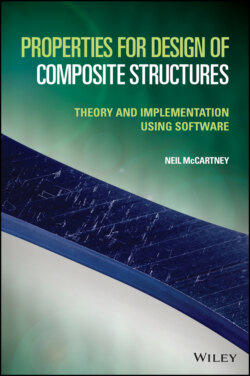Читать книгу Properties for Design of Composite Structures - Neil McCartney - Страница 39
2.18.2 Stress and Displacement Fields
ОглавлениеThe immediate objective is to determine the displacement component u3 and corresponding stresses σ11, σ12 and σ12 in terms of the mechanical loading parameters ε¯A,ε^A,ε¯T,ε^T,σt and the temperature difference ΔT. From (2.209), (2.210) and (2.212), the in-plane stresses must satisfy the relations
(2.218)
(2.219)
On solving (2.218) and (2.219) for the stresses, it follows that
(2.220)
(2.221)
where
(2.222)
It is noted that the in-plane stresses are only linear functions of x3. It then follows, on using (2.210), that all the equilibrium equations (2.120)–(2.122) are satisfied.
It now only remains to determine the value of the displacement component u3 describing the deflection of the beam. From (2.216) and (2.220)
(2.223)
On using (2.215) and (2.222) it can be shown that
(2.224)
so that (2.223) may now be written as
(2.225)
Integration with respect to x3 then leads to
(2.226)
As the shear stresses σ13 and σ23 are everywhere zero, it follows from (2.143), (2.209) and (2.211) that
(2.227)
Integration then yields
(2.228)
These relations must be consistent with (2.226) so that
(2.229)
where the displacement component has been selected to be zero at the origin.
The through-thickness displacement of the top surface of the beam, at x3=0, can be defined in terms of two lengths, R1 and R2, which are the radii of curvature of this surface in the x1–x3 plane and the x2–x3 plane, respectively. The exact relationships are given by the well-known formulae
(2.230)
For small deflections
(2.231)
Thus, it follows from (2.229) that
(2.232)
providing a useful physical interpretation of the strain parameters ε^A and ε^T.
The final requirement is to determine the loading state that is consistent with the various strain parameter values. It is assumed that stresses within the beam can arise from an applied in-plane loading that is equivalent to an applied axial force FA and a transverse force FT acting in the mid-plane between the upper and lower surfaces of the beam, and an axial applied bending moment per unit area of cross section MA and a transverse applied bending moment per unit area of cross section MT. From mechanical equilibrium
(2.233)
(2.234)
where σA and σT are the effective axial and transverse applied stresses. On substituting (2.220) and (2.221) into (2.233), the following effective axial and transverse stresses are obtained
(2.235)
(2.236)
The relations (2.234) are now expressed in the form
(2.237)
On substituting (2.220) and (2.221) into (2.237) the following relations, enabling the determination of the effective axial and transverse bending moments per unit area of cross section, are obtained
(2.238)
(2.239)
On using (2.235) and (2.236) it follows that
(2.240)
(2.241)
